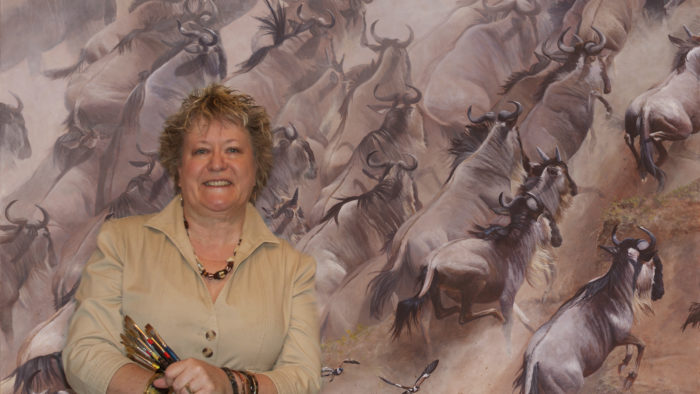Artists for Wildlife and Nature (AWN) will be holding its eight art show in January at the Venkatappa Art Gallery in Bangalore. On exhibit will be the art work of professional and amateur artists who wish to portray nature through their work.
Nearly 26 Wildlife Senior artists from Delhi, Dehradun, Mumbai, Gujarat, Tamil Naidu, Kerala will be competing for the ‘Artists of the Year’ title. There are 15 Junior Wildlife artists and a total of 92 wildlife artworks will be on display at the gallery.
Judging the art work is renowned American conservationist and artist Jan Martin McGuire. Talking to CSP about the importance of the exhibition Jan says, “Awareness raising is the key - and artists and their art can play a huge role,” in creating awareness about conservation.
Born in the foothills of the Rockies in Colorado, Jan developed an early love of the out of doors. She spent her childhood ‘climbing trees, catching snakes and drawing the animals she loved.’ A student of fine art at the University of Tulsa, Jan decided to move away from the university’s curriculum of totally modern/abstract art to pursue her own path.
To study her subjects, Jan has travelled extensively all over North America including Alaska, British Columbia, Ontario, Yellowstone, Montana, the Everglades and the deserts of the Southwest. To study neo-tropical rainforest Jan has traveled to Guatemala, Peru (where she lead a group for the National Zoo upriver on the Amazon), and Costa Rica.
As judge of the AWN art completion, Jan says she doesn’t have any favourites among the many works she has judged in the last few years. “I enjoy the variety of depictions of all the wildlife found in India.”
Asked if there is a difference in the way Indian artistes portray nature based on culturalisation, Jan says not really. “That has not been my experience with AWN. But that is typical of this genera. The depiction of wildlife tends to be a direct inspiration of nature and thus is not usually influenced in other ways.”
While Jan has not travelled to India, she looks forward to it. “I have not had the privilege of traveling to India. I’ve always wanted to see tigers - I know that has become difficult, so not sure which of the reserves we would target.”

Osprey by Prasad Natarajan, Wild life artist and founder AWN
In terms of paintings of nature in India, Jan says that “Tigers tend to be depicted frequently as they are an iconic animal, breathtakingly beautiful and becoming increasingly rare. The beautiful birdlife is also a favourite to depict.”
Drawing on her experiences of exploring nature, in combination with the visual tools of the photos, sketches, study skins etc. she has at her fingertips, Jan sets about creating the art that is her homage to the nature she loves.

Jan with her painting - Beastly Battle
Working in Acrylic (Chromacolour) on canvas, Jan creates the fine details, textures and lighting that are the hallmarks of her work. Her website says “manipulating the paint with her brushes, sponges, saranwrap and fingers, Jan creates lifelike renditions of fur, feathers, mosses and rocks. The surrounding habitat is always scientifically correct, yet an artistic backdrop to the main subject of the wildlife she is depicting. Jan’s goal is for the viewer not to feel as if they are viewing a fine painting, but rather, that they are actually seeing and experiencing the scene itself.”
Asked what makes Acrylic her preferred medium, Jan says “I am an impatient painter. I hate the drying time of oils (as well as the smell). I paint multiple thin coats (acrylic is water based until it dries - then it is permanent), which I dry even faster with a hair dryer. The stiffer bodied works best for details that I like to depict.”
It is impossible not to feel the love for the wild on seeing the paintings. Organisations like AWN help people to engage more with nature through art. There are many photographers who capture the wild, but paintings are different, says Jan.
“Because wildlife won’t “pose” while we paint them, it is necessary to work from photographs. However, in copying someone else’s photo you have not had experience of the encounter. It is important to get out into nature and see the wildlife and habitat, smell the earthy smell, feel the wind on your skin, touchy spongy moss so that that information gets into your head and is transferred in your art and learn to use a camera as the first “tool” in your tool chest, getting the lighting right, the composition etc. which then can be combined with multiple other photos (once the light is matched) to help use as reference to create our work.”





